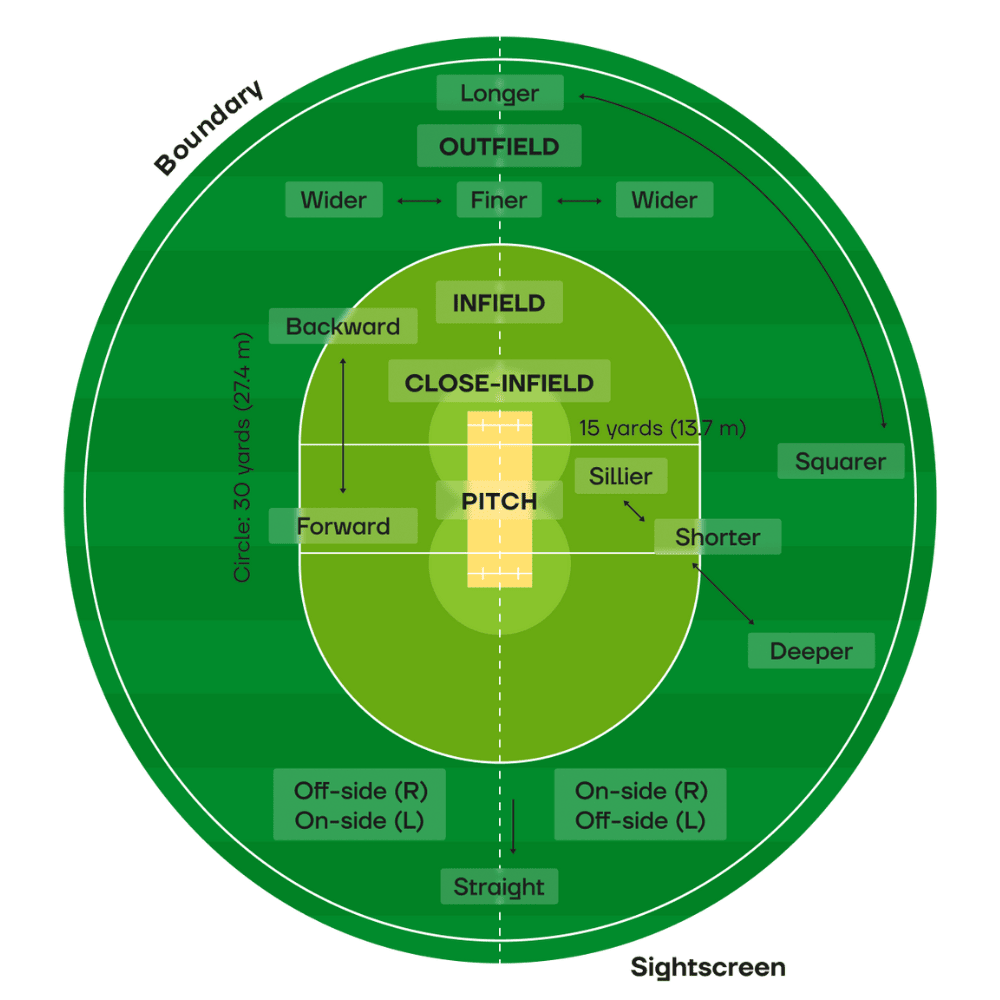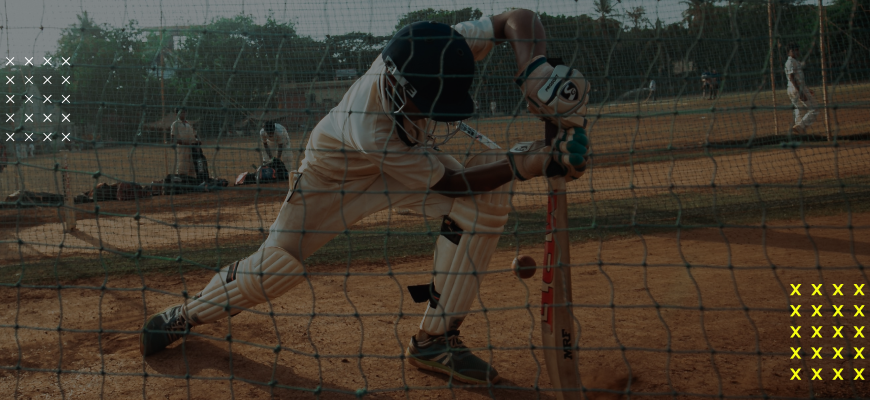In cricket, the term ‘boundary’ is usually referred to as a ‘perimeter of the playing field’ or ‘a scoring shot’ where the ball crosses the set perimeter earning four or six runs for the batting team.

It is often referred to as the boundary if we draw an imaginary straight line from the stumps and mark a white line around the ground. The batsman tries to hit the ball beyond the boundary (line marked) and usually tries to target two nearest marked points in distance from the batting end of the pitch.
Table of Contents
What Is a Six in Cricket?
Let’s imagine that the batsman hits the ball, and the first bounce is outside the field, or if it touches an object or player outside the field. In this case, the umpire awards 6 runs for the shot and refers to it as a ‘six’. This explanation is available in Marylebone Cricket Club (MCC) Law 19.7.1:
What Is a Four in Cricket?
If the ball’s first bounce is within the field of play or if the ball has not touched the bat without coming in contact with the boundary line or crossing the field of play, then the umpire awards 4 runs for the shot or simply a ‘four’. Here is an explanation from Marylebone Cricket Club (MCC) Law 19.7.2. as follows:
– whether struck by the bat or not;
– was first grounded within the boundary;
– has not been struck by the bat.”
If the batsman completes more runs before the ball touches the boundary line, he would add a more significant number of runs to the batting team and the batsman’s total score instead of the boundary.
In shorter formats like T20 cricket, colossal importance is on the number of boundaries scored and the frequency of the ball crossing the playing area, especially as a ‘six’ is valued highly in such matches. Fewer boundaries for a few overs in a T20 game or even a 50-over match puts pressure on the batting team, which often results in a beneficial situation for the fielding team.
It is essential to understand the importance, significance, and usual frequency of boundary hits in different formats of cricket before placing a bet.
Records of Most Boundaries
Test Cricket
In Test cricket, former New Zealand skipper Brendon Mccullum holds the record for most sixes with 107 in his career, overtaking the previous record of 100 sixes by Adam Gilchrist.

Former Pakistan fast bowling all-rounder Wasim Akram holds the record for most sixes in a single test match as he hit 12 sixes against Zimbabwe in 1996. The record for most sixes in a single test match belongs to the 2006 Faislabad test match between arch-rivals Pakistan and India, as the batsmen hit 27 sixes in total, with the hosts smashing 18 sixes while the visitors pounded 9 sixes as well.
ODI Cricket
In ODIs, former Pakistan spin bowling all-rounder Shahid Afridi, known for his sheer power-hitting abilities, holds the record for most sixes with 351 sixes in 369 ODI innings.
The record for most sixes in a single ODI belongs to England skipper Eoin Morgan who hit 17 sixes against Afghanistan during the 2019 ICC Cricket World Cup. Most sixes in a single ODI match were recorded in the game between England and West Indies in 2019, with the ball aerially crossing the fence a total number of 46 times, with the English scoring 24 sixes while the Caribbean side hit 22 sixes in reply.
T20 Cricket
In T20Is, New Zealand opening batsman Martin Guptill holds the record for most sixes as he has hit 165 in 108 T20 innings. Two matches (West Indies vs. India in 2016 and Australia vs. New Zealand in 2018) at 32 sixes tie the record for most sixes in a single T20I.
In all forms of T20 cricket, the self-acclaimed ‘Universe Boss’ Chris Gayle holds the record for scoring the most sixes, with his maximums count crossing 1000.
International Cricket
Only a few players reached 6 sixes in a single over in an international cricket match. Herschelle Gibbs (for South Africa in 2007) was the first player to achieve the feat, followed by Yuvraj Singh (for India in 2007), Keiron Pollard (for West Indies in 2021), and Jaskaran Malhotra (for the United States in 2021).
Domestic Cricket
Sir Garfield Sobers (for Nottinghamshire in 1968) was the first player to achieve the same feat in top-level domestic cricket, followed by Ravi Shastri (for Bombay in 1985), Ross Whiteley (for Worcestershire in 2017), Hazratullah Zazai (for Kabul Zwanan in 2018), Leo Carter (for Canterbury Kings in 2020), and Thisara Perera (for Sri Lanka Army Sports Club in 2021).
Final Thoughts
While betting, you will need to guess the total number of sixes and fours in the match or the batsman with the most number of sixes and fours. While analyzing the same, one should remember the batsmen and the bowlers involved in the game they are betting on, along with the size of the boundary in the ground, past boundary venue records, weather, and pitch conditions.
Follow the Parimatch blog for more betting tips and predictions! We provide up-to-date information on our website and live statistics of each game in the domestic, international, and foreign leagues. Be the first to know the freshest cricket statistics and build a successful betting strategy.
If you are new to cricket, there are many other fascinating things to learn about this sport. Feel free to check out some of our other articles related to cricket:
FAQ
What is the boundary rule in cricket?
In cricket, the boundary rule revolves around the boundary line, which is the perimeter of a playing field. If the batsman strikes the ball and it crosses the boundary line and grounds beyond it, the batting side scores six runs. If it crosses the line along the field boundaries, the number of runs awarded is four.
How long is the boundary in cricket?
According to the ICC Test Match Standard Playing Conditions, the playing area should be a minimum of 137.16 m. The field includes the shorter two square boundaries, which measure 59.43m. However, the exact dimensions may differ from one venue to the next.
What is the difference between four and boundaries?
The difference between four and boundaries is that four is always a boundary, but every boundary is not always a four. The scoring of either four or six runs from a single delivery is termed boundary scoring in cricket. While aerial balls that drop beyond that boundary line mean a “6”, the same for grounded instances is a 4 (four).
How many players can be on a boundary in cricket?
During the first six overs of an innings in T20 cricket, a maximum of 2 fielders can stand outside the 30-yard circle. After this, a maximum of 5 players are allowed outside it. The powerplay rules allow two players outside the line for the first ten overs of an ODI. The numbers change to four and five for the phases 11-40 overs and 41-50 overs.
What is the difference between “boundaries” and “fours” in cricket?
In cricket, the term “boundaries” and “fours” are related but distinct. A “boundary” refers to the scoring of four or six runs from a single delivery, achieved when the ball either reaches or crosses the physical boundary of the field. If the ball rolls to the boundary, it counts as a four, while if it clears the boundary in the air, it is considered a six.
